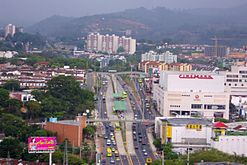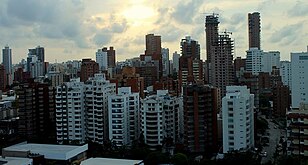Metropolitan Areas in Colombia are officially designated administrative and census areas, composed of an urban center and its associated Municipalities.

Description
The following criteria must be met for a group of communities to be designated a Metropolitan Area:
- Each one of the Municipalities, the secondary cities as well as the central city, must have a population of at least 50,000 inhabitants.
- The secondary cities must integrate their city planning with that of the central city.
- At least two-thirds of those employed in the area must perform non-rural activities.
- Each of the secondary cities must have at least 10% of their workers employed in the central city.
Commuting to work is, in fact, the major characteristic of a Metropolitan Area. As a result, the secondary cities are often called "dormitory cities"; meaning places where the inhabitants only go home to sleep.
An important function of the Metropolitan Areas is to provide for joint planning between the Municipalities, thereby managing ordered and proportional economic growth according to the necessities of the area and the physical characteristics of each Municipality.
Metropolitan Areas
The following are currently (2007) recognized by the Colombian government:
| Metropolitan Area | Status | Conurbation municipalities | Population (2018 estimate) |
|---|---|---|---|
| Greater Bogotá | Not yet defined officially | Bogotá, Soacha, Mosquera, Funza, Madrid, Chía, Cajicá, La Calera, Sopó, Tenjo, Tabio, Sibaté, Zipaquirá, and Facatativá | 9,498,470 |
| Greater Medellín | Officially the Metropolitan Area of Aburrá Valley | Medellín, Bello, Barbosa, Copacabana, La Estrella, Girardota, Itagüí, Envigado, Caldas,Rionegro and Sabaneta | 4,035,922 |
| Greater Cali | Not yet defined officially | Cali, Palmira, Yumbo, Jamundí, Vijes and Florida | 3,079,074 |
| Greater Barranquilla | Created by Decree 28 of 1981 | Barranquilla, Puerto Colombia, Soledad, Galapa and Malambo | 2,098,966 |
| Greater Cartagena de Indias | Not yet defined officially | Cartagena de Indias, Turbaco, Turbana, Clemencia, Santa Catalina, Santa Rosa and Villanueva | 1,197,656 |
| Greater Bucaramanga | Created by Decree 20 of 1981 | Bucaramanga, Floridablanca , Piedecuesta y Girón | 1,150,993 |
| Greater Cúcuta | Created by Decree 000508 of 1991 | Cúcuta, Villa del Rosario, Los Patios and El Zulia | 866,633 |
| Greater Pereira | Created by Decree 014 of 1991 | Pereira, Dosquebradas, La Virginia, Santa Rosa de Cabal | 786,476 |
| Greater Valledupar | Created in 2005 | Valledupar, Codazzi, La Paz, Manaure and San Diego | 584,682 |
| Greater Armenia | Not yet defined officially | Armenia, Calarcá, Circasia, La Tebaida, Montenegro and Salento | 504,722 |
| Greater Girardot | Not yet defined officially | Girardot, Ricaurte (Cundinamarca) and Flandes (Tolima) | 146,039 |
| Greater Ibagué | Not yet defined officially | Ibagué, Cajamarca, Alvarado, Coello and Piedras | 613,370 |
| Greater Ipiales | Not yet defined officially | Ipiales, Pupiales, Carlosama, Aldana | 173,773 |
| Greater Manizales | Not yet defined officially | Manizales, Neira, Chinchiná, Villamaríanota and Palestina | 559,433 |
| Greater Montería | Not yet defined officially | Montería, Cereté, San Carlos, Ciénaga de Oro and San Pelayo | 694,937 |
| Greater Neiva | Not yet defined officially | Neiva, Rivera, Palermo, Tello, Campoalegre, Baraya, Aipe and Villavieja | 461,479 |
| Greater Santa Marta | Not yet defined officially | Santa Marta, Pueblo Viejo and Ciénaga | 645,007 |
| Greater Popayán | Not yet defined officially | Popayán, El Tambo, Timbío, and Piendamó | 413,210 |
| Greater Sincelejo | Not yet defined officially | Sincelejo, Corozal, Morroa, Los Palmitos and Sampués | 422,906 |
| Greater Tunja | Not yet defined officially | Tunja, Sora, Soracá, Siachoque, Toca, Tuta, Sotaquirá, Cómbita, Motavita, Oicatá, Chivatá, Cucaita, Samacá and Ventaquemada | 294,918 |
| Greater Villavicencio | Not yet defined officially | Villavicencio, Acacías, Guamal, Restrepo and Cumaral | 629,029 |
| Greater Sogamoso | Not yet defined officially | Sogamoso, Duitama, Paipa, Nobsa, Tibasosa, Santa rosa de Viterbo, Firavitoba and Iza | 309,922 |
External links
- Se consolidan en el país las áreas metropolitanas, PORTAFOLIO, 15 de Junio de 2006
- Sorpresas del censo[permanent dead link]




